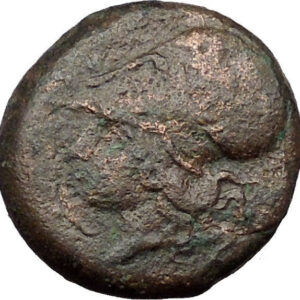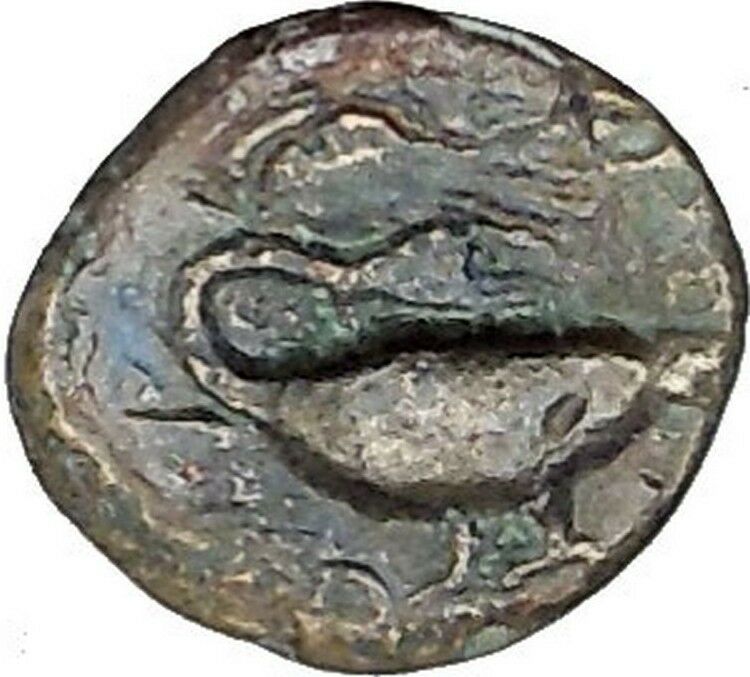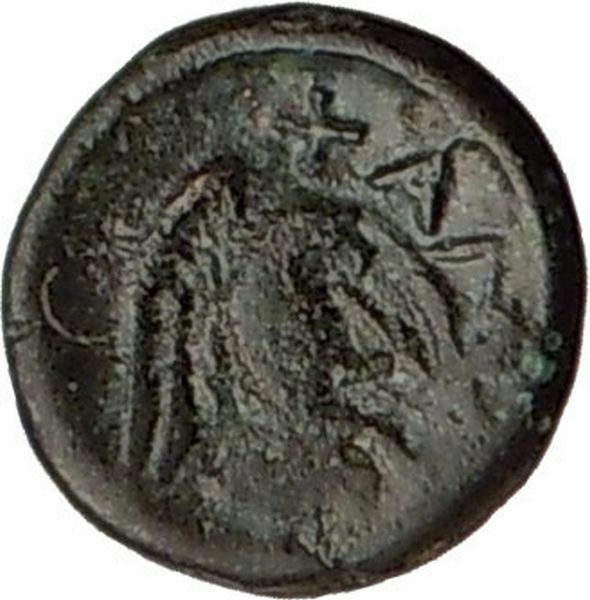|
Greek city of Castulo in the Ulterior Province of Spain
Bronze Unit 26mm (9.81 grams) Struck circ late 2nd Century B.C.
Reference: CNH 38; SNG BM Spain 1323-37
Diademed male head right; to right, facing hand.
Sphinx advancing right; star to right.
Phoenician and Greek contact with Spain stretched back to the
Seventh Century B.C. at least; possibly several centuries earlier in the case of
the Phoenicians. A liverly trade was carried on with the rich mining culture
based on the city of Tartessos, but about 500 B.C. the Carthaginians destroyed
Tartessos having already taken control of the Phoenician settlements in Spain.
Carthaginian pre-eminence in southern and eastern Spain lasted until the time of
the Punic Wars between Carthage and Rome. It was from Spain that Hannibal
launched his famous invasion of Italy which came so close to destroying the
Roman Republic in the infancy of its power. But Hannibal was defeated and Spain
became a Roman province (206 B.C.). During the Second Century B.C. Rome
gradually extended her influence into the interior of the country and permitted
the Iberian tribes to issue a native currency bearing Iberian legends. This
coinage ceased with the provincial reforms carried out in 133 B.C. The various
civil was in Spain in the First Century B.C. saw the temporary revival of bronze
issues from certain mints. It was not until 19 B.C., in the reign of Augustus,
that the whole of the peninsula came under Roman control with the conquest of
northwestern Spain.
You are bidding on the exact item pictured,
provided with a Certificate of Authenticity and Lifetime Guarantee of
Authenticity.
A sphinx is a
mythical creature
with, as a minimum, the body of a
lion and the head of a human or a cat.
In Greek tradition, it has the haunches of a lion, the wings of a great bird,
and the face of a woman. She is mythicised as treacherous and merciless. Those
who cannot answer her riddle suffer a fate typical in such mythological stories,
as they are killed and eaten by this ravenous monster.[1]
Unlike the Greek sphinx which was a woman, the Egyptian sphinx is typically
shown as a man (an androsphinx). In addition, the Egyptian sphinx was
viewed as benevolent in contrast to the malevolent Greek version and was thought
of as a guardian often flanking the entrances to temples.

In
European decorative art, the sphinx enjoyed a major revival during the
Renaissance
. Later, the sphinx image, something
very similar to the original Ancient Egyptian concept, was exported into many
other cultures, albeit often interpreted quite differently due to translations
of descriptions of the originals and the evolution of the concept in relation to
other cultural traditions.
Generally the role of sphinxes is associated with architectural structures
such as royal tombs or religious temples. The oldest known sphinx was found near
Gobekli Tepe
at another site, Nevali Çori,[2]
or possibly 120 miles to the east at Kortik Tepe,
Turkey
and was dated to 9,500 BC.
Egyptian sphinxes
The sphinx is located in the north and below the pyramids. What names their
builders gave to these
statues
is not known. At the Great Sphinx site,
the inscription on a stele
by
Thutmose IV
in
1400 BCE
, lists the names of three aspects of
the local sun deity of that period,
Khepera
–Rê–Atum.
The inclusion of these figures in tomb and
temple
complexes quickly became traditional and
many pharaohs had their heads carved atop the guardian statues for their tombs
to show their close relationship with the powerful solar deity,
Sekhmet
, a lioness. Other famous Egyptian
sphinxes include one bearing the head of the pharaoh
Hatshepsut
, with her likeness carved in
granite
, which is now in the
Metropolitan Museum of Art
in New York, and the
alabaster
sphinx of Memphis
,
Memphis, Egypt
, currently located within the
open-air museum at that site. The theme was expanded to form great
avenues
of guardian sphinxes lining the
approaches to tombs and temples as well as serving as details atop the posts of
flights of stairs to very grand complexes. Nine hundred with ram heads,
representing Amon
, were built in
Thebes
, where his cult was strongest.
Perhaps the first sphinx in Egypt was one depicting
Queen Hetepheres II
, of the
fourth dynasty
that lasted from
2723
to
2563 BC
. She was one of the longest-lived
members of the royal family of that dynasty.
The largest and most famous is the
Great Sphinx of Giza
, sited at the
Giza Plateau on the west bank of the
Nile River
and facing due east (29°58′31″N
31°08′15″E).
It is also from the same dynasty. Although the date of its construction is
uncertain, the head of the Great Sphinx now is believed to be that of the
pharaoh Khafra
.
The Great Sphinx has become an emblem of Egypt, frequently appearing on its
stamps, coins, and official documents.[4]
Greek traditions
From the Bronze Age
, the Hellenes had trade and cultural
contacts with Egypt. Before the time that
Alexander the Great
occupied Egypt, the Greek
name, sphinx, was already applied to these statues. The historians and
geographers of Greece wrote extensively about Egyptian culture. Heredotus called
the ram-headed sphinxes, criosphinges, and the hawk-headed ones,
hieracosphinges
.
The word sphinx comes from the
Greek
Σφίγξ, apparently from the verb σφίγγω (sphíngō),
meaning “to squeeze”, “to tighten up”.[5][6]
This name may be derived from the fact that the hunters for a pride of lions are
the lionesses, and kill their prey by strangulation, biting the throat of prey
and holding them down until they die. The word
sphincter
derives from the same root.
However, the historian Susan Wise Bauer suggests that the word “sphinx” was
instead, a Greek corruption of the Egyptian name “shesepankh,” which meant
“living image,” and referred rather to the statue of the sphinx, which
was carved out of “living rock” (rock that was present at the construction site,
not harvested and brought from another location), than to the beast itself.[7]
There was a single sphinx in Greek mythology, a unique demon of
destruction and bad luck. According to
Hesiod
, she was a daughter of
Orthus
[8]
and either
Echidna
or the
Chimera
, or perhaps even
Ceto;[9]
according to others, she was a daughter of Echidna and
Typhon
. All of these are
chthonic
figures from the earliest of Greek
myths, before the Olympians ruled the Greek
pantheon
. The Sphinx is called Phix (Φίξ) by
Hesiod
in line 326 of the
Theogony
, the
proper name
for the Sphinx noted by
Pierre Grimal
‘s The Penguin Dictionary of
Classical Mythology.
In
Greek mythology
, a sphinx is represented as a
monster with a head of a woman, the body of a
lioness, the wings of an
eagle
, and a
serpent
headed tail.
The sphinx was the emblem of the ancient city-state of
Chios
, and appeared on seals and the obverse
side of coins from the 6th century BC until the 3rd century AD.
Athena appears in the middle of the upper-half of the middle of a sarcophagus
found in the middle pyramid of Giza, with two sphinxes at her side.

Assyrian
Lamassu
dated 721 BC Institute
Museum, University of Chicago.

Marble Sphinx dated 540 BC Acropolis Museum, Athens
The Riddle of the
Sphinx
The Sphinx is said to have guarded the entrance to the Greek city of Thebes,
and to have asked a riddle of travellers to allow them passage. The exact riddle
asked by the Sphinx was not specified by early tellers of the stories, and was
not standardized as the one given below until late in Greek history.[10]
It was said in late lore that
Hera or Ares
sent the Sphinx from her
Ethiopian
homeland (the Greeks always
remembered the foreign origin of the Sphinx) to
Thebes
in Greece where she asks all passersby
the most famous riddle
in history: “Which creature walks on
four legs in the morning, two legs in the afternoon, and three legs in the
evening?” She strangled and devoured anyone unable to answer.
Oedipus
solved the riddle by answering: Man—who
crawls on all fours as a baby, then walks on two feet as an adult, and then
walks with a cane in old age. By some accounts[11]
(but much more rarely), there was a second riddle: “There are two sisters: one
gives birth to the other and she, in turn, gives birth to the first. Who are the
two sisters?” The answer is “day and night” (both words are feminine in Greek).
Bested at last, the tale continues, the Sphinx then threw herself from her
high rock and died. An alternative version tells that she devoured herself. Thus
Oedipus can be recognized as a “liminal”
or threshold figure, helping effect the transition between the old religious
practices, represented by the death of the Sphinx, and the rise of the new,
Olympian
gods.
In Jean Cocteau
‘s retelling of the Oedipus legend,
The Infernal Machine
, the Sphinx tells
Oedipus the answer to the riddle, to kill herself so that she did not have to
kill anymore, and also to make him love her. He leaves without ever thanking her
for giving him the answer to the riddle. The scene ends when the Sphinx and
Anubis
, who is there to kill the victims who
cannot answer the riddle, ascend back to the heavens.
There are mythic, anthropological, psychoanalytic, and parodic
interpretations of the Riddle of the Sphinx, and of Oedipus’s answer to it.
Numerous riddle books use the Sphinx in their title or illustrations.[12]
Castulo was an
Iberian
town located in the
Andalusian
province of Jaén
, in south-central
Spain
. Evidence of human presence of since the
Neolithic
period has been found there.
Oretans was the name of the
Iberian
tribe which settled in the vicinity in
the north of the
Guadalquivir River
beginning in the 6th century
BCE. Of tradition, a local princess named Himilce married
Hannibal
and gained the alliliance of the city
with the Carthaginian Empire
.
In 213 BCE, Castulo was the site of a
Hasdrubal Barca
‘s crushing
victory
over the Roman army with a force of
roughly 40,000 Carthaginian troops plus local Iberian mercenaries. Thereafter
the Romans
made a pact with the residents of
city —who then betrayed the Carthaginians— and the city became an
foederati
(ally) of Rome.
Castulo began to lose importance while Andalusia fell under Islamic rule in
the Middle Ages. In contrast, the nearby village
Linares
grew in reputation due to its strong
castle — first built as an Arab fortress, then rebuilt by the Chrisitians after
the Reconquesta — overlooking the city.
In 1227 its walls were destroyed, and the town was depopulated shortly
afterwards.
|










